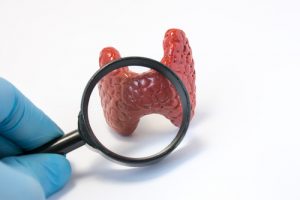Thyroid and menopause are interactive, and reactions vary. Knowing how they are related and being familiar with available treatments may help avoid discomfort.
Estrogen is the hormone in women that regulates the reproductive system and development of female characteristics. Menopause is a natural and inevitable stage in women as estrogen declines in the body later in life. The thyroid makes hormones that interact with estrogen.
The Complexities of Estrogen
It is probably better to say “estrogens” because estrogen is a group of hormones under the same umbrella: estrone (E1), estradiol (E2), estriol (E3) and estetrol (E4). Estriol is most influential during pregnancy, and estrone plays a more decisive role during and after menopause. Estradiol is dominant in non-pregnant women after menarche (periods) begin to decline. Estetrol is made only during pregnancy.
Thyroid and Estrogen Hormones
Thyroid hormones and estrogen interact and act on organs and cells in many parts of the female body. These interactions affect temperature, metabolism, mood and energy levels. Menstruation and bones are involved too. The interactive variables may work with or against others and may enhance the qualities of one another.
As estrogen declines and the thyroid changes with age, some typical symptoms appear associated with menopause. From perimenopause (pre-menopause) to post-menopause, increases in urinary infections, sleep problems, mood changes, weight changes and vaginal dryness become evident in many cases. Very few women remain symptom-free, and some women have significant symptoms.
Thyroid Disorders

Thyroid disorders become more common with age. Several tests are available to get a valuable diagnosis for medical interventions. The thyroid-stimulating hormone (TSH) can be measured to determine if hypothyroid or hyperthyroid conditions exist. TSH is affected by T3 and T4 hormones in the thyroid. The levels of these can be tested for a more insightful diagnosis.
Other conditions may interact with estrogen decline. Autoimmune conditions can cause hypothyroidism or hyperthyroidism. Goiter is a condition resulting from an enlarged thyroid and the presence of thyroid nodules; both can be cancer precursors.
Thyroid and Menopause—Dual Diagnosis
Menopause is an unavoidable life stage, and it is treated symptomatically, but thyroid disease can be controlled to an extent. With a dual diagnosis, there are many and varied symptoms. Complex hormonal changes can cause menstruation variations, digestive problems, insomnia, a drop in energy, mood disorders, weight gain and more—no definitive list of symptoms exists.
Treatment
Thyroid and menopause treatments are available. For hypothyroid, there are hormone prescriptions for boosting the thyroid. Hyperthyroid conditions may require medications, a medical procedure and perhaps radiation treatment. Your thyroid should be routinely monitored once an appropriate treatment is started.
After a complete assessment, mood disorders are treated with medications. Monitoring hormones helps establish and adjust the dosage, and hormone treatment may be short or long-term depending on symptoms and testing. For perimenopause and menopause, hormonal supplements are often used.
Overall health is essential, as other conditions can complicate menopause; it’s crucial to work on general health and wellbeing with healthcare professionals. Symptomatic conditions need to be reported for possible treatments. Many over-the-counter supplements are advertised as helping with symptoms; however, patients should discuss any supplements with their doctor before starting a course.
Being Health-Mindful
Be proactive with medical professionals—be a member of the team. Health problems with the thyroid and menopause are a possibility that is easily detected. The most important consideration is that symptoms are treatable: It’s in your hands. The sooner you know, the better, and the sooner you get relief.





